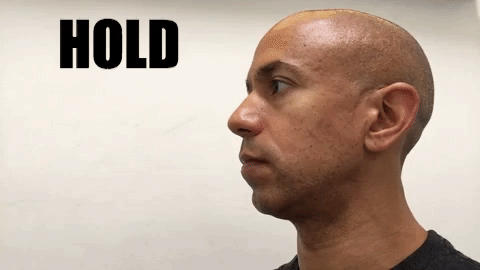This past weekend, I took part in a 3-day functional training summit in Long Beach, CA.
I had a chance to listen to some amazing expert presenters whom I admire and respect.
They discussed the most critical topics with up-to-date science on human performance. All the stuff that I love and am excited to share with you.
The one topic that stood out as the most important by far was BREATHING.
They all agree that most athletes are missing out on training this key element.
As a result, there’s been an epidemic of preventable conditions such as:
- Anxiety
- Asthma
- Poor recovery
- Limited mobility
- Low back / hip pain
- And shoulder and neck injuries
If you’ve suffered from any of the above, then your breathing may be the culprit.
Read on to learn a simple:
A) Test to see how you measure up.
B) Breath training method that can help you improve your:
- Recovery
- Durability
- Endurance
- Mental state
- Core strength
- And energy creating ability
HENCH TEST
For this test, you will time your own breath hold. This creates a deprivation of adequate oxygen (hypoxia) and increases carbon dioxide (hypercapnia).
Your ability to tolerate this internal environment will determine your baseline breathing status.
Follow these safety instructions:
- Sit in a chair relaxed, and breathe with normal inhalation and exhalation for one minute.
- Pinch off your nose after a normal exhalation through your mouth. This is your cue to start the timer.
- Hold your breath as long as you can, without going to a feeling of extreme discomfort.
- Stop the clock when you first open your mouth.
- Record your time.
- Use the chart below to determine your status.
HYPOXIC TRAINING (i.e. controlled breath holds)
Studies show that this training method can improve your oxygen efficiency. This means that you could lessen the load on your respiratory muscles. So your endurance will improve.
Hypoxic Training also signals processes in your body to ward off negative effects of stress. This occurs through a stimulation to your vagus nerve. This particular nerve is part of your autonomic nervous system. It controls the heart, blood pressure, lungs, and digestive tract.
Tapping into your vagus nerve gives you better control over your sympathetic and parasympathetic nervous systems. These control your fight or flight response and rest and digest process, respectively.
So practicing breath holds will improve your potential for down regulation (lower heart rate and higher oxygen consumption). This helps you recover faster, and perform at higher levels.
You can do this type of training in almost any position (seated, standing, lying down, etc.). Another option is the Child’s Pose Breathing exercise that I discussed in my last message.
As a practical rule, work on breath holds only following an exhale. This equates to a low risk and high reward.
To be consistent in this new practice, start by setting alarm reminders for several times a day. When the alarm sounds, pinch off your nose following a normal exhale. And hold your breath until you feel the need to breathe.
The first inhale should feel normal. So there should be no hyperventilation in an attempt to catch your breath. If, that happens, you must learn to listen to your body, and control your response.
Often times, that first big gasp for breath is out of a mental panic, and not a physical need for oxygen. Understanding this, you can condition yourself to take a smaller breath in following the hold.
Inhaling and exhaling through the nose only will help you to regulate this process best.
As you gain better control over your breath, you can combine breath holds with low intensity activity.
Here’s an example for walking or jogging. (Andreev, 2005):
- Hold breath — 4 steps
- Exhale — 2 steps
- Hold breath — 4 steps
- Repeat for a short duration of 5 minutes and 5 minutes off to start. As you adapt over a period (weeks) of time, progress to longer durations.
The above intermittent applications will condition your body’s tolerance to hypoxia and hypercapnia. So you can improve upon your baseline status, and experience all the benefits to your fitness.
That’s a win-win.
To get more great tips, techniques and exercises to become an Athlete For Life, subscribe to my YouTube Channel.
Until next time, stay athletic.
Your coach,
Adam


